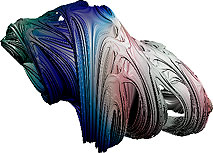
|
||
| Release 4.0 | ||
 |
Quaternion Parameters

In order to create a Quaternion fractal it is necessary to specify several parameters: Calculating them is a complicated task (for me to write the routines...), especially if the user should be able to change everything. So please let me explain in short terms the meaning of the 6 tabs available in the parameter window. I tried to organize the parameters, and hopefully most of the time you will work only with a few of these... |
 Parameter Parameter | This tab contains parameters to define the 3D sub space from the 4D Quaternion space. If you want to know more about the specific parameters, see Parameter Tab If you want to know more about Quaternion numbers, see Quaternion Math. And if you want to know more about how ChaosPro defines 3D sub spaces from a 4D space, see Theory about Quaternions |
 View View | The previous tab lets you define a 3D sub space from the 4D Quaternion space. This tab now lets you specify all items related to the observer: This includes the observer position, the observer orientation and the view direction. A detailed description of each parameter can be found at View Parameters. |
 Light Light | This tab lets you specify all available light settings: This includes the light position, the intensity, etc. . ChaosPro uses a variation of the Phong lighting model. Of course, ray tracing programs would produce much better results, but the quality seems to be sufficient for a fractal generator. More info can be found at Light Parameters. |
| The previous three tabs let you specify all parameters which affect the view: The 3D sub space, the observer, the light. The next three tabs now let you specify all the fractal related stuff: Some transformation, the iteration formula, the coloring to apply. | |
 Transformation Transformation | This tab lets you specify an initial transformation formula: Just as with the Escapetime fractal one can define transformations in the Quaternion space using the compiler. This transformation gets applied to the initial value. A more detailed description can be found at Quaternion Transformations. |
 Formula Formula | Here you can choose the iteration formula and specify parameters for the selected formula. A more detailed description can be found at Quaternion Formulas. |
 Coloring Coloring | And the last tab lets you choose the coloring algorithm to use. The settings there do not affect the shape of the fractal, they only affect the colors of the object. A more detailed description can be found at Quaternion Coloring. |
In order to navigate through a quaternion object the following special mouse actions are possible inside the rendering window:
- Mouse Wheel: Using the mouse wheel you can zoom in and out
- Double click with the left mouse button zooms in by 20% onto the selected pixel.
- A special zoom mode exists for Quaternion:
You can set the viewpoint, the observer and the "right side" directly and then tell ChaosPro to use these values and start rendering: Hold down the Ctrl key and click onto the Quaternion with the left mouse button. The first click sets the viewpoint, the second click sets the observer and the third click sets the "right side". You cannot move around the points, but if you continously click you can set the viewpoint again, then the observer, etc.
If you want to remove all points, hold down the Ctrl key and double click with the left mouse button.
If you want to use these values, release the Ctrl key and double click with the left mouse button.
If you want to use these values, but want to look at the object from above (i.e. use the values and rotate by 90 degrees vertically), then press the Shift key and then double click with the left mouse button.
The latter is the one which I prefer most: By pointing onto the Quaternion I cannot define a point which is "above" the Quaternion. So it was implemented that way: Define three points, viewpoint, observer and where is right, and then rotate the observer by 90 degrees so he still looks at the viewpoint and still the right side is at the right side...










